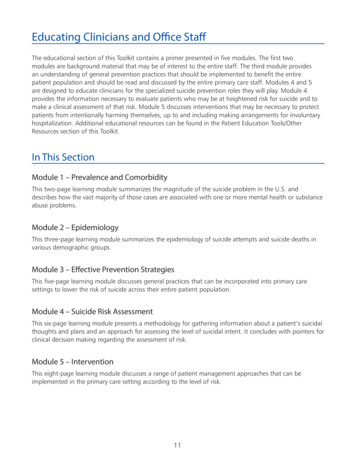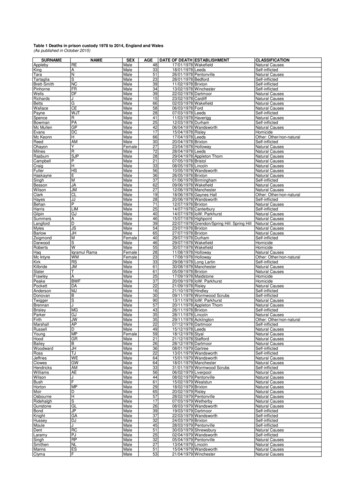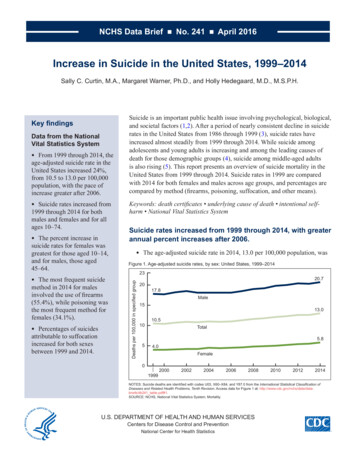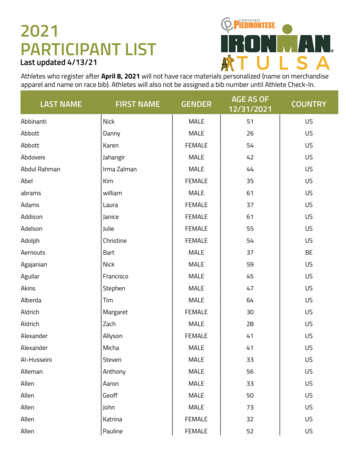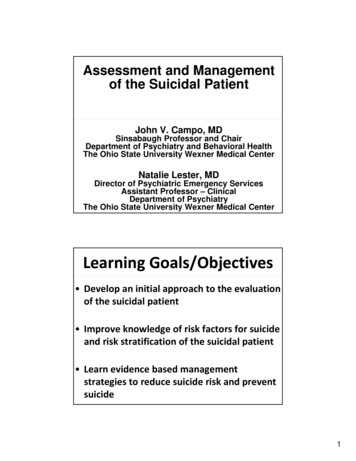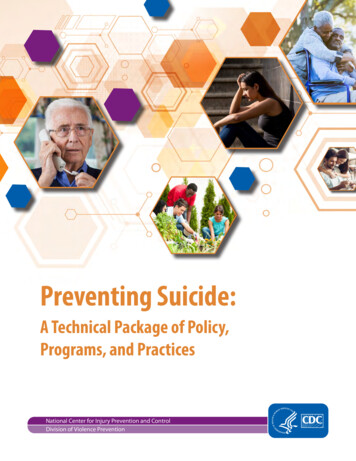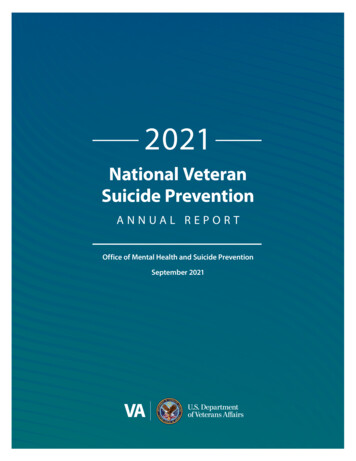
Transcription
Milner et al. BMC Public Health (2017) 17:584DOI 10.1186/s12889-017-4500-8RESEARCH ARTICLEOpen AccessMale suicide among construction workersin Australia: a qualitative analysis of themajor stressors precipitating deathAllison Milner1,2* , Humaira Maheen2, Dianne Currier3 and Anthony D LaMontagne1,2AbstractBackground: Suicide rates among those employed in male-dominated professions such as construction areelevated compared to other occupational groups. Thus far, past research has been mainly quantitative and hasbeen unable to identify the complex range of risk and protective factors that surround these suicides.Methods: We used a national coronial database to qualitatively study work and non-work related influences onmale suicide occurring in construction workers in Australia. We randomly selected 34 cases according to specificsampling framework. Thematic analysis was used to develop a coding structure on the basis of pre-existing theoriesin job stress research.Results: The following themes were established on the basis of mutual consensus: mental health issues prior todeath, transient working experiences (i.e., the inability to obtain steady employment), workplace injury and chronicillness, work colleagues as a source of social support, financial and legal problems, relationship breakdown andchild custody issues, and substance abuse.Conclusion: Work and non-work factors were often interrelated pressures prior to death. Suicide prevention forconstruction workers needs to take a systematic approach, addressing work-level factors as well as helping thoseat-risk of suicideKeywords: Suicide, Male construction workers, Life stressor, Job stress, AustraliaBackgroundLike many other OECD countries, suicide is a leadingcause of death among men in Australia [1]. Past researchsuggests that over half of the men who lose their lives tosuicide are employed at the time of death [2]. Certainsubgroups within the working population appear to beparticularly vulnerable to suicide, including menemployed in the construction industry [3–5]. A pastmeta-analysis of international studies published over theperiod 1979 to 2012 indicated that suicide rates amonglower skilled workers in construction were 80% higherthan the general working age population [3]. Worryingly,two later studies (using data from Australia and the* Correspondence: allison.milner@unimelb.edu.au1Centre for Health Equity, Melbourne School of Population and GlobalHealth, The University of Melbourne, Melbourne, Australia2Deakin Population Health Strategic Research Centre, School of Health &Social Development, Deakin University, Geelong, AustraliaFull list of author information is available at the end of the articleUnited Kingdom) demonstrated that suicide amongworkers in low-skilled industries have increased substantially over time [4, 5].Explanations for why suicide deaths are so prominentamong these males have largely drawn on sociologicaland psychological perspectives. In the UK, Roberts et al.[5] show that the variation in suicide between occupational groups due to socio-economic factors doubledfrom the period 1970 to 2005. The study concluded thatsocio-economic conditions were a major determinantof male suicide among those in “manual occupations”(including construction) [5]. Others have focused onwork-related stressors particular to construction, including the insecurity of work due to short term contracts, a fluctuating job market, long work hours,workplace bullying, and the use of alcohol and drugsin the workplace [6]. Researchers have also highlightedpotential risk factors such as lack of mental health The Author(s). 2017 Open Access This article is distributed under the terms of the Creative Commons Attribution 4.0International License (http://creativecommons.org/licenses/by/4.0/), which permits unrestricted use, distribution, andreproduction in any medium, provided you give appropriate credit to the original author(s) and the source, provide a link tothe Creative Commons license, and indicate if changes were made. The Creative Commons Public Domain Dedication o/1.0/) applies to the data made available in this article, unless otherwise stated.
Milner et al. BMC Public Health (2017) 17:584literacy and stigma [7], as well as the influence of “stoicism” as a barrier to help seeking in these traditionalmasculine environments [8]. As it stands however,most of these explanations are mainly speculative, asthey have drawn on data collected from non-suicidalsamples [6–8], rather than qualitative accounts of thosewho actually lost their lives to suicide.The limited amount of qualitative research in thisspace is reflective of the field in general, in which research on male suicide is generally lacking. Among thesmall amount of studies in the area, one has focused onsuicide attempts among males rather than deaths [9].This study of 34 men who had attempted suicide revealed a number of key risk factors, including: mentalhealth problems, unhelpful conceptions of masculinityconsisting of stoic beliefs, social isolation and use ofother non-social coping strategies, and life stressors [9].Stack & Wasserman’s [10] qualitative study of the coronial records of males who had died by suicide found thatloss of income, debt, legal issues and workplace conflictwere proximal risk factors for suicide. Perhaps the mostnotable contribution is this area is the work of Scourfield [11] and Shiner [12] who conducted a “sociologicalautopsy” of 100 cases of suicide. Working with coronialdata, these authors highlight the importance of relationship problems, work, and mental illness in male suicidecases. None of these studies have specifically focused onsuicide among those who had been employed in theconstruction industry. The aim of this study is to deepenunderstandings of the risk factors associated with suicideamong males in the construction industry, with a particular focus on work and employment context. Asnoted above, there has been a lack of qualitative researchon the factors that might be underpinning the high ratesof suicide among this occupational group. Based on theresearch cited above, we would argue that constructionworkers may be particularly at risk of suicide because ofwork and social contexts that compound life stressorsand mental health issues.MethodsData sourceWe identified suicide cases using the National CoronialInformation System (NCIS). The NCIS is an internetbased data storage and retrieval system that enables coroners, government agencies, and researchers to monitor external causes of death in Australia and to identify cases forfurther investigation and analysis. In every state ofAustralia, coroners investigate all suspected cases of suicide and produce a report that describes the circumstances and underlying cause of death. The standardformat of corners’ report includes demographic information, circumstances of death and cause of death on thebasis of autopsy, police report, and toxicology reports. InPage 2 of 9the study sample, we noted that the length of each coroners’ report varied from one page to 24 pages and it wasdependent on the circumstances of deaths and coronersdescription style.The quality and completeness of NCIS data varies between cases, particularly for the early years of thescheme (e.g., 2000), and suicide may be under-reportedbecause of legislative and professional differences between states and between coroners [13]. In addition,there is a significant lag between a person’s death and recording in the NCIS, caused by delays of up to threeyears in the coronial process. We classified suicidemethods according to the International Classification ofDisease, 10th revision (ICD-10), codes X60–X84 [14].Occupations were classified according to the Australianand New Zealand Standard Classification of Occupations(ANZSCO) [15].Sample selectionWe conducted a keyword search of ‘police reports’ and‘coronial findings of suicide cases’ occurring within theperiod January 2010–December 2014 to identify recentmale suicide cases that mentioned work-related stressorsat the time of death. The NCIS database allow comprehensive search by using Boolean or Wildcard searchqueries. The following individual keywords were used toidentify possible cases: work, stress, bully, compensation,job insecurity, long hours, physical work, conflict, supervisor, boss, harassment, discrimination, redundancy,downsizing, or salary. We conducted a number of teststo ensure that these search terms returned all relevantcases. Each query resulted in a number of NCIS cases,and a few times, an NCIS case appeared more than onetime in search queries. Once the keyword search wascomplete, the query results were combined, and duplicates were removed. The final list of cases consist of1619 male cases employed at the time of death.We then stratified these cases on the basis of occupational skill level (based on the ANZSCO) [15], and sevenage groups [15–19, 20–29, 30–39 . 70 & more] to ensure an equal representation of occupational groupingand age. After the stratification, cases were selected randomly from each occupation skill level group and agegroup. We then inspected case reports to assess theavailability of information about occupation and workhistory. Again, cases selected for review were selectedrandomly from within each of the stratified occupationand age groups.On the basis of preliminary analysis of all occupationcoding, we decided to group the cases from ANZSCO 3,7 and 8 because of their theoretically similar workingconditions in terms of being employed in the construction industry. For sample size, we aimed for at least 30cases as there is a general consensus among qualitative
Milner et al. BMC Public Health (2017) 17:584Page 3 of 9researchers that a sample size to be 20–50 participantswill provide adequate information for qualitative analysis[16–18]. Moreover, we also used data saturation technique [19] to inform us where to stop including morecases; which in the case of this study was 34 cases. Thisprocess of case selection presented above resulted infinal sample of 14 cases from ANZSCO 3 Techniciansand Trades Workers, 9 cases from ANZSCO 7 Machinery Operators and Drivers and 13 cases from ANZSCO8 Labourers. More information on the process of selecting cases can be seen in Additional file 1.structure. After the first stage of coding, the codingstructure was revised on the basis of mutual consensusbetween the two coders. The second round of codingwas done by one researcher on the basis of finalisedcodes, however, the final codes are reviewed and approved by both researchers. As suicide is a multidimensional phenomenon, we also allowed content to beselected in multiple codes, hence the same content canfit into more than one category. Code frequencies ofeach ANZSCO code (3 vs 7) and (7 vs 8), (3 vs 8) werecompared to identify the similarities and differences between different them.Data analysisThematic analysis is a process of encoding qualitative information under a theme and presenting the repeated information in a systematic way that increases its sensitivityand reliability in order to answer the research question[20]. Recently, a number of studies had used thematic analysis method to analysis coroners’ reports [11, 12, 21, 22]by using inductive and deductive approach. The main difference between inductive and deductive reasoning is thatdeductive reasoning is based on a hypothesis to test a theory whereas the inductive reasoning generates theorythrough interpretation of the data.Our overall approach was similar to those described inScourfield [11] in that we took a wider sociological perspective in the assessment of suicide among males. Withinthis overarching framework, we used deductive process ofthematic analysis to identify, analyse, and report repeatedpatterns (themes) from coroners’ report [23–25]. Nvivo11.0 was used for data analysis (QSR International PtyLtd). To protect individual indentity, names, ages and geographical locations have been altered.Coding strategyCoding of coroners’ reports was done in two stages. Inthe first stage, a coding structure was developed on thebasis of pre-existing theories in job stress research. Toincrease rigour, the selected coroners’ reports werecoded line by line by two independent researchers. Indoing first-stage coding, both researchers noted potentialnew codes that could have been added to the codingResultsThe sample included 34 cases of male suicide. The agerange of cases can be seen in Table 1, as well as the occupational grouping of cases. Two thirds of the caseswere of the age between 20 and 49 years. In terms ofmental disorder (n 17), depression was mentioned in11 cases. There were two cases that mentioned a diagnosis of schizophrenia, two cases of Attention Deficit Disorder, one case of Bipolar Disorder, and one unspecifiedmental illness. In other cases, mental health problemwas not mentioned an issue.In the qualitative accounts of suicide by coronial reports, we found evidence of a range of stressors recorded as being proximal to suicide, including workrelated stressors (e.g., work transition, workplace injury),stressors that could be either work or non-work related(e.g., work colleagues as witnesses, financial and legal issues, and substance abuse), and non-work relatedstressors (e.g. relationship dissatisfaction). Results showthat these stressors frequently co-occurred and interacted in these men’s lives, along with other risk factorssuch as mental illness.Transient working experiences (n 10)There were notable age differences in transient work experiences. While the young had difficulties regarding thetransition from school to work and finding permanentwork, older workers had issues adjusting to new workingenvironments. Arthur was a 21-year-old labourer whoTable 1 Cases included in the qualitative analysis, by age group and occupational groupingAge groupsTechnicians and Trades Workersn (%)Machinery Operators and Driversn (%)Labourersn (%)Total15–191 (100.0)0 (0.0)0 (0.0)1 (100.0)20–293 (37.5)3 (37.5)2 (25)8 (100)30–394 (50)1 (12.5)3 (37.5)8 (100)40–493 (42.86)2 (28.57)2 (28.57)7 (100)50–592 (28.57)3 (42.8)2 (28.5)7 (100)60–691 (33.3)1 (33.3)1 (33.3)3 (100)Total14 (41.1)10 (29.4)10 (29.4)34 (100)
Milner et al. BMC Public Health (2017) 17:584experienced problems in finding permanent work (although he was officially recorded as employed at thetime of death in his coronial record).The deceased at the time of his death was betweenjobs, having previously been employed in variouslabouring-related jobs, mostly on a casual basis. Theseinclude, but are not limited to, construction, demolition, and gardening-related jobs. At the time of hisdeath, the deceased had last worked on a building site,having been employed on a casual basis his father attributed [the suicide] to the breakdown of his relationship and his inability to find steady employment.(Arthur, Labourer)Adam had issues settling into a new work place. Before that, he was working on contractual basis with different energy companies. Three days before his death bysuicide, he started working as a labourer in a new worksite. Adam also had a history of illicit drug use and hadmade suicide attempts in the past.Page 4 of 9David had a history of depression following surgery fora work related injury. As a consequence of this injuryhe suffered chronic pain and was seeking treatmentfrom his general practitioner and psychiatrist. (David,Tradesperson)Pain and limited mobility were linked to the loss ofwork, long term sickness absence and depression. Someof those with workplace injuries also reported treatmentfrom psychiatrists for mental health issues. Ryan injuredhis back in an accident many years ago and he reinjuredhimself in a car accident one week before he suicided.According to his friend, he complained about his soreback the last time they spoke. He had recurrent workplace injuries which were thought to have contributed toongoing pain and depression.The deceased had a sore back accident. He said hehad injured it in a car accident. He reinjured it atwork a week ago. (Ryan, 48, Painter).Role of work colleagues (n 10)Adam attended lunch with his family for his mother’sbirthday. He expressed anger and frustration about hisfirst day at work. He did not want to return to workthe following day. (Adam, Labourer)Arthur and Adam both reported feeling anxious, unhappy and frustrated about work problems. In boththese cases, the family members were aware about thepresence of workplace stress in the deceased’s life.Other cases also frequently reported personal issues,which possibly hindered their ability to deal with workplace stressors. For example, Scott was a 63-year-oldbuilder who had just been terminated from work because he was unable to meet job demands. He hadmultiple other stressors at the time of death, includingthe death of his mother, a recent relationship breakdown, financial and legal issues, and a recent workplace injury. These factors reportedly had a profoundeffect on his mental health and his ability to concentrate at work.Workplace injury (n 4)Workplace injuries were reported among a number ofmiddle-aged and older workers. These injuries wereoften accompanied by another kind of severe pain ordisability which limited a person’s mobility. For example,David had surgery for a hernia as a result of a work related injury. According to his wife, the deceased hadbeen on Work benefits (duration was not mentioned).Due to ongoing financial difficulties he had to return towork. At the time of death, he was wearing his uniformwhich indicated that he worked that day.In 10 cases, work colleagues were the first ones to noticethe absence of the deceased, or be the first person to findthe deceased after their suicide. They also acted as important witnesses in the police reports. Sometimes the nameof work colleagues were mentioned in suicide notes, indicating the level of trust and value the deceased gave tothat person. For example, work colleague Michael was thefirst to find James, a 26 year old construction worker.His friend Michael came in the morning to his houseto collect the deceased for work. This is a usualroutine. On arrival the deceased was not waiting atthe front of the residence as he usually is Michaelhas walked into the premises and has located thedeceased lying on the kitchen floor with a 22 riflelocated beside him. (James, Construction worker)In another case, 24-year-old construction worker Stephen had confided in work colleague Paul about his intent to suicide just one day before his death.Last night I got home from work. Stephen came to myplace to have a chat about him and how he was feeling.We spoke about an incident that occurred a while agowhere he was talking about hanging himself with a ropethat he had in his hand. (Stephen, Constructionworker)Financial issues (n 7)Of the financial issues, the inability to pay tax loans wasreported most frequently. These tax debts reportedlyhad a flow on effect on employability and ability to
Milner et al. BMC Public Health (2017) 17:584obtain further loans. Scott was a builder and had notmade a tax return for three years prior to his death.Scott also had recent life events including the death ofhis mother and legal issues with his former partner.Adam also had problems adjusted to a new working environment and had a history of drug use.The deceased was a builder and had beenexperiencing significant financial problems over thepast 18 months as a result of tax debts, courtproceedings and his business dealings. His tax debthad a substantial impact on his ability to undertakebuilding constructions due to his inability to gainhome warranty insurance. A large amount of financialand legal documentation was located in piles on thekitchen bench of the residence, suggesting the deceasedhad been experiencing significant financial difficulties.(Scott, Builder)Adam had about 20,000 in debts, but also assets inthe way of life insurance and superannuation. Theseassets exceeded his debts, but were not accessible tohim. (Adam, Labourer)In another case, Johns’ rent was overdue and he fearedthat the real estate might take legal action against him.This was in addition to the amount he owed to the Australian Taxation Office. Documents related to legal andfinancial issues were found at the scene of death.There was a letter on behalf Australian Taxationoffice stating amount owing and documents fromCentrelink. His wife further stated the deceased wasoverdue with his rent for the last 3 weeks and believedthe real estate was taking action to recover overduepayments (John, Plasterer)Legal problems (n 4)Legal problems were mentioned under a number of different circumstances including workplace legal issues, financial crisis (e.g. debt, taxation), and post-divorce legalmatters. There were two cases where workplace legal issues were identified as a major stressor preceding death.In one case, the deceased suicided while he was beinginvestigated for stolen items (e.g. rakes, top soil etc.)from work sites. The deceased had previously disclosedhis concern about this investigation to his wife. Although, according to his work supervisor, other employees were also being investigated.Page 5 of 9that it was in relation to some planks of wood that hehad bought home. (Cooper, Road service worker)Scott was a builder who had a number of legal issuesprior to death. He had multiple other stressors includingthe death of his mother, a recent relationship breakdown, financial and legal issues, and a recent workplaceinjury.The deceased was involved in a number of civil legalproceedings involving his ex-partner and mother of histwo children, and former clients of his business. (Scott,Builder)Relationship breakdown and child custody issues (n 18)Marriage break up and relationship issues emerged as animportant theme amongst 18 workers.The defacto was in a relationship with the deceasedfor three years and they lived together until a week agowhen their relationship ended resulting in him movingout. Since moving out the deceased had been depressedand having trouble accepting that the relationship wasover. (Kraig, Machinery worker)In another case, Hunter was a 25-year old that wasupset about some offensive remarks made by his formerpartner on social media.He had split from his girlfriend that morning. He readsome derogatory remarks regarding the split onFacebook. (Hunter, Truck driver)Separated or divorced men with young children appeared to have issues in negotiating access to their children. Francis had been recently separated from thepartner and was upset being not able to meet with hischildren on a frequent basis. These issues were alsonoted in his suicide note.The deceased’ and his partner’s relationship was onand off for many years, with her and the childrenmoving in and out of the home on multiple occasions.The two remained in regular contact regardingfinancial matters and matters over the children.Hostility remained between the two as the deceasedwanted his wife to return to the family home with thechildren. (Francis, Forklift Driver)Substance abuse (n 7)His wife noticed that he seemed a bit down and askedwhat was going on. He showed her a letter from workthat suggested he was being investigated for ‘the use ofwork resources for personal gain’. He told his wifeThe use of substances such as heroine, methamphetamine (commonly known as “ICE”), Methylenedioxymethamphetamine (commonly known as Ecstasy),cannabis and chronic heavy drinking was noted in seven
Milner et al. BMC Public Health (2017) 17:584out of 34 cases. Adam was a labourer with a heroine addiction who had multiple stressors at the time of death.Adam had a long history of substance abuse, includingillicit drugs and prescription medication. His treatinggeneral practitioner, Dr. Joe Good reported that Mr.Adam was addicted to heroin with heavy daily use. Hecommenced the methadone program on a few monthsago, however he was observed to have great difficultyceasing heroin use. (Adam, Labourer).In another instance, Francis (a forklift driver) mentioned that he has been using the drug ICE, which oftencaused him to be violent. He had issues with his partnerand also made suicide attempts in the past.He was known by family members to occasionally usethe drug ‘Ice’ which caused his behaviour to becomeerratic and violent, thus eventually leading to thebreakdown of their relationship. (Francis, ForkliftDriver)DiscussionOverview of main findingsThis study highlights several important proximal risksprior to the suicide of construction workers. Many ofthese stressors reflected work and industry related factors, such as job insecurity, transient working conditions, issues connected to business and financialmanagement, and fear of legal prosecution in relation todebt and conduct at work. We would argue that thesework related risks reinforce the cultural norms aboutmasculinity in the construction industry, and in combination heighten the risk of suicide among constructionworkers. Substance issues, alcohol use and mental healthissues were other prominent factors recorded in the suicide of these workers. Our analysis also revealed familybreakdown and the lack of access to children as majorstressors. It appears that colleagues at work played animportant role in terms of being a confidant and havingregular face-to-face contact with the deceased prior totheir death.Study limitationsAs identified in Scourfield et al. [11], a problem in relying on coronial data is that it is likely to have identifiedonly a specific range of risk factors that were obvious tothose in the investigation of suicide cases, next-of-kinand other witnesses. There is also likely to be problemsrelated to recall bias. We would also highlight that oursample will not comprehensively cover all stressors facing those employed in construction. Thus, there will beother factors (e.g., bullying) that we did not identify inthis study which have been previously cited as risks forPage 6 of 9suicide [6]. Despite this limitation, our thematic analysisdid identify many of the same risk factors as identifiedin past research. We would also acknowledge the possibility that our approach overestimates the importance ofsome work-related stressors. It is also important to notethat all of the themes we discussed above will be interrelated and that, more than likely, it is difficult to distinguish or disentangle work from non-work related issues.For example, lack of job security, and ongoing financialissues are likely to flow over to affect relationship dynamics, and vice versa, which could be mediated by feelings of inadequacy or other pathways. Thus, risk factorscombine to create a ‘perfect storm’, in which workers willbe particularly vulnerable to suicide.Another limitation is that this type of analysis is notable to adequately assess distal, chronic or long-termrisks. For example, those employed in construction areoften subject to low job control (characterised by thelack of ability to have a say over how and when work isconducted), high job demands and long working hours,driven by industry-related timelines. These psychosocialstressors have been identified as risk factors for a largenumber of common mental health problems, chronic illnesses and mortality [26–28]. Even more relevant to thecurrent study, a recent publication using a populationlevel case-control design identified low control and highdemands as key risk factors for suicide amongemployed males [29]. This corroborates past researchfrom other countries [30–35] and highlights these asadditional factors raising the risk of suicide amongworkers in these occupations. Similarly, coronial reports would be unlikely to explicitly highlight the circumstances of mental health problems, mental healthstigma and lack of help-seeking. However, as we mention below, these are recognised risk factors in theconstruction industry. We would also acknowledge thefact that the study findings may lack generalizabilitydue to its small sample size and explicit focus onconstruction.Identified risk factors for suicide among men inconstructionEmployment opportunities in the construction industryare closely tied to fluctuations in the national economy.The need to be responsive to wider global economicmarket means that the industry has a highly casualisedworkforce that is dependent on available contracts forongoing work [36]. Because of this, workers in the industry are more likely to be exposed to job insecurity,which has been identified as a risk factor for mental illhealth across a number of studies [28]. In the context ofour study, we would suggest that the overarching structure of the industry fuels a number of the work-relatedrisk factors seen in our study, including job insecurity
Milner et al. BMC Public Health (2017) 17:584and transient working conditions, as well as feelings ofpressure at work and debt.Financial, legal, relationship, and family related stressorsand were also identified in our qualitative study, as in previous studies [11, 37, 38]. Other factors identified in past research [11, 38] such as sexual jealousy and concern aboutthe stability of housing were not apparent in our smallstudy. Mental illness and substance use was apparent inover half of cases, supporting the argument that this is amajor risk factor for suicide [39]. Although we did not haveinformation on diagnosis in all cases, coronial reports indicated problems such as mood disorders and schizophrenia.Often there was a combination of stressors apparent in aperson’s life before they died by suicide. This highlights thecomplex and multi-layered number of factors present inthese mens’ lives before their suicide. For example, widerstructural factors in the construction industry such as jobinsecurity are likely to combine with latent factors such asgreater stigma against mental illness and help seeking tocreate an environment whe
Data source We identified suicide cases using the National Coronial Information System (NCIS). The NCIS is an internet-based data storage and retrieval system that enables coro-ners, government agencies, and researchers to monitor ex-ternal causes of death in Australia and to identify cases for further investigation and analysis. In every state of
